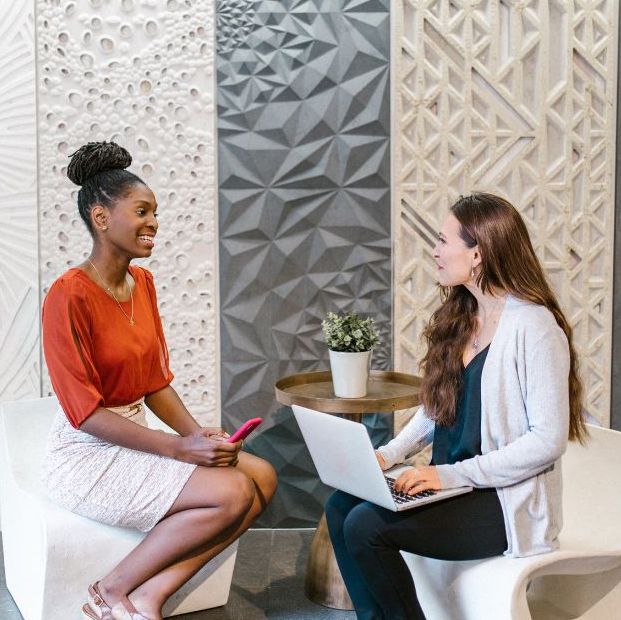10 Steps To Set The Right Conversational Tone In An Interview
These FAQs address the most common questions that people may have when it comes to planning, preparing for, conducting, and analysing interviews for various purposes. These FAQs are applicable to a wide range of industries and situations, such as academic research, radio broadcasting, podcast or webinar hosting, journalism, job interviews, and many others. The information provided also delves into specific aspects of the interview process, including planning for individual or group/focus group interviews, important considerations during interviews, effective questioning techniques, different interviewing styles, and the steps to review and interpret the outcomes after the interview has taken place.
How Do I Maintain a Conversational Tone While Conducting a Structured Interview?
In the realm of interviews, whether you’re a researcher, journalist, podcaster, or human resource manager, the ability to maintain a conversational tone is a valuable skill. But what exactly does a “conversational tone” mean? It’s about striking a balance between structure and informality, where the interviewee feels comfortable, and the conversation flows naturally.
This quick guide explores key techniques and strategies to achieve this delicate equilibrium.
10 Key Steps To Set The Right Conversational Tone
#1 Know Your Audience
Understand your interviewee’s background and preferences. Tailor your questions and tone to match their expectations. For example, if you’re interviewing a tech expert, use technical jargon when appropriate. Understanding your audience is a foundational element of maintaining a conversational tone during interviews.

Beyond knowing the basics, delve deep into your interviewee’s background and preferences. Explore their professional journey, personal interests, and communication style. For instance, if you’re about to interview a seasoned tech expert, research their contributions to the field, their recent projects, and any areas of special interest.
Tailoring your questions and tone to align with their expectations is crucial. If your interviewee is from a highly technical background, don’t shy away from using technical jargon when it’s appropriate. This demonstrates your familiarity with their world and can foster a sense of shared expertise. On the other hand, if you’re speaking with a non-technical audience, make sure to simplify complex concepts and explain jargon when necessary.
#2 Prepare Conversation Starters
Begin the interview with light, open-ended questions that help break the ice. For instance, you could ask, “Tell me about your journey into this field. How did it all start?”
The initial moments of an interview are pivotal in setting the tone. To create a welcoming atmosphere, start with engaging and open-ended questions. These questions serve as icebreakers, encouraging the interviewee to open up and share their experiences and insights. For instance, you might inquire, “Tell me about your journey into this field. How did it all start?” This kind of question invites the interviewee to reflect on their personal and professional evolution.
Moreover, crafting specific conversation starters that align with the interviewee’s background can help establish a connection right from the beginning. If your interviewee has a history of innovative projects, asking them to share the story of their most exciting project can ignite their passion and set a conversational tone.
#3 Active Listening
Listen attentively to the interviewee’s responses and show genuine interest. This not only makes the interviewee feel valued but also opens up opportunities for follow-up questions.
Active listening is a cornerstone of maintaining a conversational tone throughout the interview. It goes beyond just hearing the words – it’s about genuinely absorbing and responding to what’s being said. When you listen attentively, the interviewee not only feels valued but also senses that you are engaged in the conversation, rather than merely going through a checklist of questions.
Show your interest through verbal and non-verbal cues. For example, nod when the interviewee makes a significant point, or provide verbal affirmations like “I see what you mean” or “That’s fascinating.” These responses validate the interviewee’s contributions and encourage them to share more. Active listening also opens the door for follow-up questions. When you’re attuned to the nuances of the interviewee’s responses, you can seize opportunities to delve deeper into their insights and experiences.
#4 Use Natural Language
Avoid overly formal or jargon-heavy language. Speak in a way that resonates with your audience and doesn’t create a communication barrier.
To maintain a conversational tone, it’s essential to use language that resonates with your audience. Avoid overly formal or jargon-heavy language that might create a communication barrier. Your aim is to make the interviewee feel comfortable and ensure that the conversation flows smoothly. This is especially important when interviewing individuals from diverse professional backgrounds or industries.
One strategy is to conduct a pre-interview conversation to gauge the interviewee’s preferred communication style. Do they appreciate a casual conversational approach, or do they expect a more structured, formal interaction? By aligning your language with their preferences, you create a comfortable atmosphere that encourages open dialogue.
#5 Build Rapport
Invest time in establishing a connection with the interviewee. Share relevant personal anecdotes or experiences when appropriate to build trust.
Building rapport is about investing time and effort in establishing a personal connection with the interviewee. While it’s vital to maintain professionalism, don’t be afraid to share relevant personal anecdotes or experiences when appropriate. These personal touches can build trust and make the interviewee feel more at ease.

For instance, if your interviewee mentions a recent holiday or a shared interest, feel free to briefly share your own experiences or thoughts. This not only humanises the conversation but also creates a sense of camaraderie. The shared experiences can serve as conversational bridges, making the interviewee more receptive to your questions and more willing to share their insights.
#6 Maintain Eye Contact
If you’re conducting an in-person interview, maintaining eye contact conveys your attentiveness and interest in the conversation.
Maintaining eye contact is particularly important when conducting in-person interviews. It’s a non-verbal cue that conveys your attentiveness and genuine interest in the conversation. When you maintain eye contact, you signal to the interviewee that they have your full attention, and you are actively engaged in the dialogue.
In addition to eye contact, pay attention to your body language. Sit or stand in a way that’s open and inviting, showing that you are receptive to the interviewee’s thoughts. Avoid distractions, such as checking your phone or looking around the room, as this can detract from the conversational atmosphere you’re trying to create.
#7 Non-Verbal Cues
Use nods, smiles, and other non-verbal cues to show that you are engaged and responsive to the interviewee’s words.
Non-verbal cues, such as nods, smiles, and other gestures, play a pivotal role in maintaining a conversational tone. These cues indicate your engagement and responsiveness to the interviewee’s words. When the interviewee sees your non-verbal signs of agreement or empathy, it fosters a sense of connection and encourages a more open and natural conversation.
For example, a nod of approval or a warm smile when the interviewee shares a personal achievement can create a positive atmosphere and make them feel valued. Non-verbal cues are particularly essential in remote interviews, where verbal communication might be the primary mode of interaction. In these cases, your non-verbal cues can compensate for the lack of physical presence.
#8 Transition Smoothly
Guide the conversation from one topic to another seamlessly. Avoid abrupt changes that disrupt the flow of the interview.
Transitioning between topics or questions is an art that can significantly impact the flow of the interview. Abrupt changes can disrupt the conversational tone and leave the interviewee feeling disoriented. To transition smoothly, offer clear signals that you’re shifting gears and provide a brief context for the new topic.

For example, you might say, “That’s a fascinating perspective on your early career experiences. Now, I’d like to shift our focus to your recent projects. Can you tell me about the challenges you’ve encountered and how you overcame them?” This approach prepares the interviewee for the change in topic, making the transition seamless and maintaining the conversational flow.
#9 Storytelling
Incorporate storytelling techniques. Share relevant stories to illustrate points or to connect with the interviewee on a personal level.
Storytelling is a powerful technique to connect with the interviewee on a personal level and maintain a conversational tone. Sharing relevant stories can illustrate points, provide context, and create a relatable atmosphere. When the interviewee sees you as not just an interviewer but as a storyteller, it fosters a more engaging and open conversation.
Consider weaving anecdotes into your questions or responses. If the interviewee mentions a challenging situation at work, share a similar experience from your own professional life and how you handled it. These personal stories can help the interviewee relate to you on a human level and encourage them to share their own stories, fostering a conversational atmosphere.
#10 Open-Ended Questions
Use open-ended questions that encourage the interviewee to share more details. Instead of asking, “Did you like your previous job?” try, “What aspects of your previous job did you find most fulfilling?”
The types of questions you ask greatly influence the conversational tone of the interview. Open-ended questions, which cannot be answered with a simple “yes” or “no,” encourage the interviewee to share more details and insights. They promote a dialogue rather than a one-sided exchange of information.
For instance, instead of asking, “Did you like your previous job?” you can inquire, “What aspects of your previous job did you find most fulfilling?” This open-ended question invites the interviewee to reflect on their experiences and provides an opportunity for them to express their thoughts and feelings, creating a more conversational and insightful interaction.
By focusing on these aspects, you can not only conduct a structured interview but also ensure that it maintains a conversational tone, fostering a more engaging and productive conversation.
Conversational Tone Key Tips
- Know Your Audience: Understanding your audience is pivotal. For example, an HR manager interviewing a job candidate should be aware of the candidate’s professional background and aspirations. This knowledge shapes the tone and direction of the interview.
- Use Natural Language: Speak in a way that is clear and accessible to your audience. Avoid jargon or overly complex terminology, unless it’s a subject-specific interview where such language is expected.
Maintaining a conversational tone during a structured interview is an art, combining preparation, empathy, and adaptability. It’s about ensuring that your interview feels like a two-way conversation, fostering engagement and insight.
The key takeaway is that a conversational tone is not about abandoning structure but rather adapting your approach to make your interviewee feel comfortable and engaged. Remember to know your audience, employ conversation starters, practice active listening, and be mindful of non-verbal cues. Mastering these techniques will help you excel in various interviewing scenarios.
Conversational Tone Resources
Here are two valuable websites where you can find additional information and resources on interview conversation techniques and maintaining a conversational tone:
Way With Words offers professional transcription services, ensuring that your interviews are accurately transcribed. This can be immensely helpful for researchers, journalists, and podcasters looking to maintain a conversational tone while preserving the interview’s content.
Harvard Business Review often features insightful articles on communication techniques, including interview strategies and maintaining a conversational tone in professional settings.
Final Thoughts
As you ponder the techniques for maintaining a conversational tone in your interviews, consider these questions:
- What are some specific ways you can tailor your interview style to the preferences and background of your interviewee?
- Can you recall an interview experience where maintaining a conversational tone led to a more engaging and informative conversation? What techniques were most effective in achieving this?
- How can you apply the concept of maintaining a conversational tone to your specific field or industry? What unique challenges and opportunities does it present?
